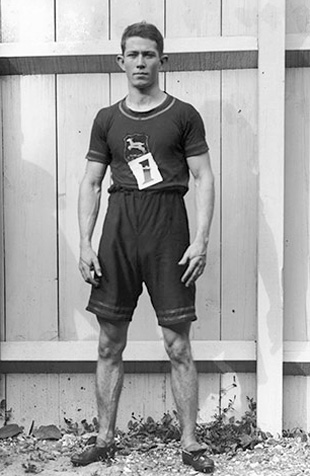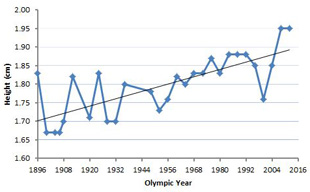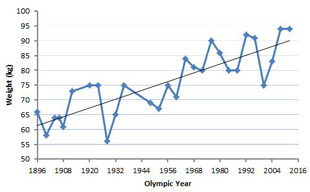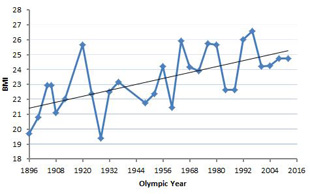The Olympic Games brings together the best athletes in the world. Studying the changes in anthropometric measurements of Olympic champions can demonstrate how athletes have changed over 100 years of sport. Here is the comparison of the men's 100m Olympic champions since the first in 1896.
The Tokyo 2020 winner Lamont Marcell Jacobs has been added to the table, but the graphs have not been updated with his details.
 Reggie Walker, the 100m champion from 1908
Reggie Walker, the 100m champion from 1908(Height 1.70 m / 5' 61⁄2", Weight 61 kg / 134 lb)
Anthropometric Measures of Olympic Champions
Here is a table of the height, weight and body mass index (BMI) of the male Olympic 100m champions for every Olympiad. Graphs are presented below which show how these measures have changed over time. Generally, the winning sprinters have become taller and heavier over time.
| Year | Winner | Time (secs) | Height | Weight | BMI |
|---|---|---|---|---|---|
| 1896 | Tom Burke (USA) | 12 | 1.83 m / 6 ft 0 in | 66 kg / 146 lb | 19.7 |
| 1900 | Frank Jarvis (USA) | 11 | 1.67 m / 5 ft 5 1⁄2 in | 58 kg / 128 lb | 20.8 |
| 1904 | Archie Hahn (USA) | 11 | 1.67 m / 5 ft 5 1⁄2 in | 64 kg / 141 lb | 22.9 |
| 1908 | Reggie Walker (SAF) | 10.8 | 1.70 m / 5 ft 6 1⁄2 in | 61 kg / 134 lb | 21.1 |
| 1912 | Ralph Craig (USA) | 10.8 | 1.82 m / 6 ft 0 in | 73 kg / 161 lb | 22.0 |
| 1920 | Charles Paddock (USA) | 10.8 | 1.71 m / 5 ft 7 1⁄2 in | 75 kg / 165 lb | 25.6 |
| 1924 | Harold Abrahams (GBR) | 10.6 | 1.83 m / 6 ft 0 in | 75 kg / 165 lb | 22.4 |
| 1928 | Percy Williams (CAN) | 10.8 | 1.70 m / 5 ft 7 in | 56 kg / 123 lb | 19.4 |
| 1932 | Eddie Tolan (USA) | 10.38 | 1.70 m / 5 ft 7 in | 65 kg / 143 lb | 22.5 |
| 1936 | Jesse Owens (USA) | 10.3 | 1.80 m / 5 ft 10 3⁄4 in | 75 kg / 165 lb | 23.1 |
| 1948 | Harrison Dillard (USA) | 10.3 | 1.78 m / 5 ft 10 in | 69 kg / 152 lb | 21.8 |
| 1952 | Lindy Remigino (USA) | 10.4 | 1.68 m / 5 ft 6 in * | 63 kg / 138 lb * | 22.3 |
| 1956 | Bobby Morrow (USA) | 10.5 | 1.86 m / 6 ft 1 in | 75 kg / 165 lb | 21.7 |
| 1960 | Armin Hary (GER) | 10.2 | 1.82 m / 6 ft 0 in | 71 kg / 157 lb | 21.4 |
| 1964 | Bob Hayes (USA) | 10 | 1.80 m / 5 ft 11 in | 84 kg / 185 lb | 25.9 |
| 1968 | Jim Hines (USA) | 9.95 | 1.83 m / 6 ft 0 in | 81 kg / 179 lb | 24.2 |
| 1972 | Valeriy Borzov (URS) | 10.14 | 1.83 m / 6 ft 0 in | 80 kg / 176 lbs | 23.9 |
| 1976 | Hasely Crawford (TRI) | 10.06 | 1.87 m / 6 ft 1.5 in | 90 kg / 198 lbs | 25.7 |
| 1980 | Allan Wells (GBR) | 10.25 | 1.83 m / 6 ft 0 in | 86 kg / 190 lbs | 25.7 |
| 1984 | Carl Lewis (USA) | 9.99 | 1.88 m / 6 ft 2 in | 80 kg / 180 lb | 22.6 |
| 1988 | Carl Lewis (USA) | 9.92 | 1.88 m / 6 ft 2 in | 80 kg / 180 lb | 22.6 |
| 1992 | Linford Christie (GBR) | 9.96 | 1.88 m / 6 ft 2 in | 92 kg / 203 lb | 26.0 |
| 1996 | Donovan Bailey (CAN) | 9.84 | 1.85 m / 6 ft 1 in | 91 kg / 201 lb | 26.6 |
| 2000 | Maurice Greene (USA) | 9.87 | 1.76 m / 5 ft 9 in | 75 kg / 165 lb | 24.2 |
| 2004 | Justin Gatlin (USA) | 9.85 | 1.85 m / 6 ft 1 in | 83 kg / 183 lb | 24.3 |
| 2008 | Usain Bolt (JAM) | 9.69 | 1.95 m / 6 ft 5 in | 94 kg / 207 lb | 24.7 |
| 2012 | Usain Bolt (JAM) | 9.63 | 1.95 m / 6 ft 5 in | 94 kg / 207 lb | 24.7 |
| 2016 | Usain Bolt (JAM) | 9.81 | 1.95 m / 6 ft 5 in | 94 kg / 207 lb | 24.7 |
| 2021 | Lamont Marcell Jacobs (ITA) | 9.80 | 1.86 m / 6 ft 1 in | 84 kg / 185 lb | 24.3 |
source: the height and weight data was collected from the Wikipedia profiles of each athlete, and when this data was not provided, it was extracted from the sports-reference.com website.
notes: * The height and weight of the 1952 winner Lindy Remigino were updated as notified by the son of Lindy's old roommate and teammate at Manhattan College, Joe Schatzle. Weight was 138 not 148lbs, and height 5 ft 6 in not 5 ft 8 in.
Height changes over time
The height of the Olympic 100m champion has generally increased since the first Olympic Games. The first winner Tom Burke was 1.83 m (6 ft) though 6 out of the next 8 winners were 1.71cm or lower. The tallest is the current champion Usain Bolt at 1.95m (6 ft 5 in).

Weight changes over time
The weight of the Olympic 100m champion has generally increased since the first Olympic Games, from around 60-70 kg (130-154 lb) in the early Olympic years up to 94 kg (207 lb) Usain Bolt.

BMI changes over time
The BMI of the Olympic 100m champion has generally increased over time. As the BMI reflects the ratio of weight to height, an increasing BMI indicates that body weight has increased to a greater extent than height. Body fat would not be expected to be higher in the modern sprinter (the opposite is probably true), so this increase in weight is probably explained by a greater muscle mass of the current sprinters.

Note: This analysis is for illustrative purposes only. The data was colected from different sources, and may also not accurately represent their actual measurements at the time of their race.
Related Pages
- Anthropometry of Olympic Athletes
- 100m Olympic Games winners list, and world record holders
- See a similar analysis of Olympic marathon champions
- Athlete Body Size Changes Over Time
- Sport Specific Anthropometry, including Athletics Anthropometry
- about BMI
- Science and the Olympics
- Olympics Anthropology Days


 Current Events
Current Events